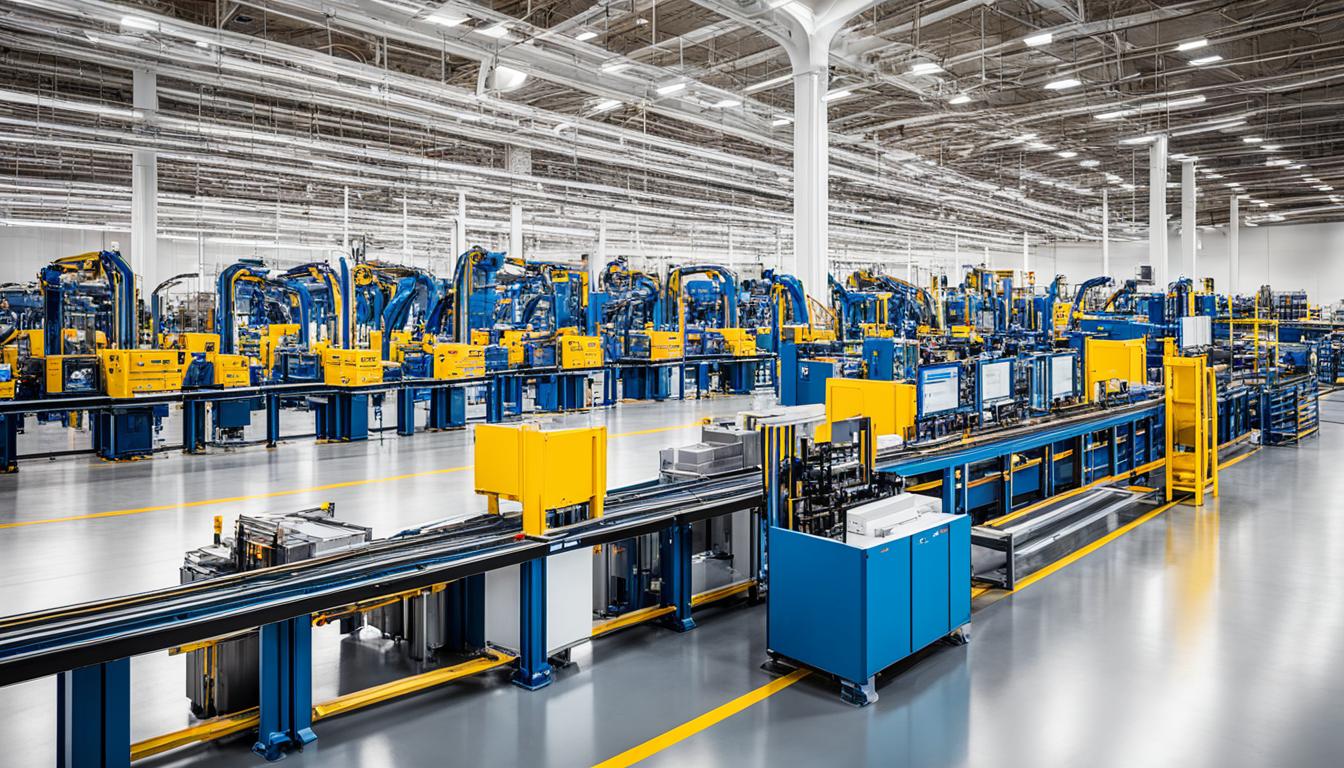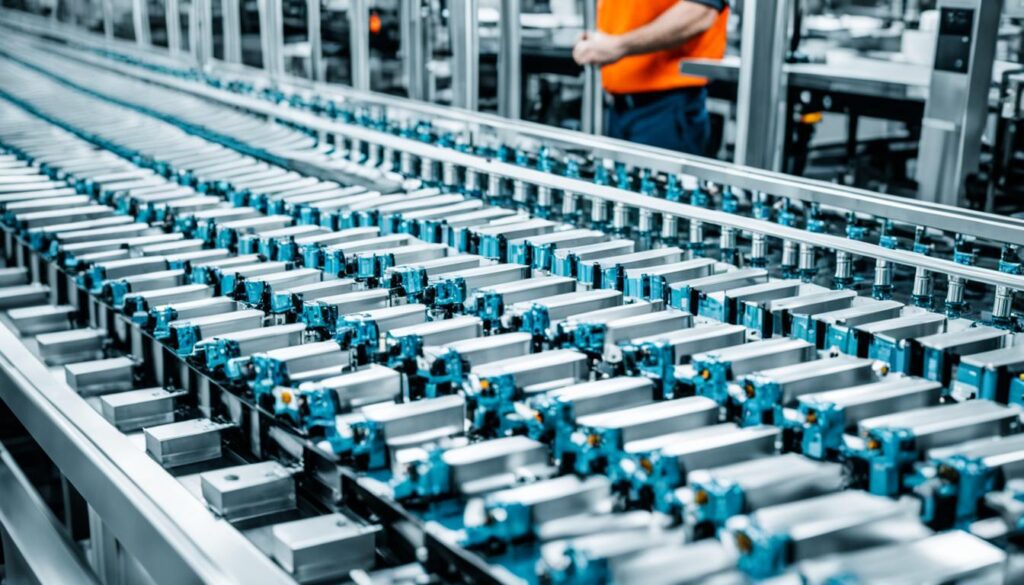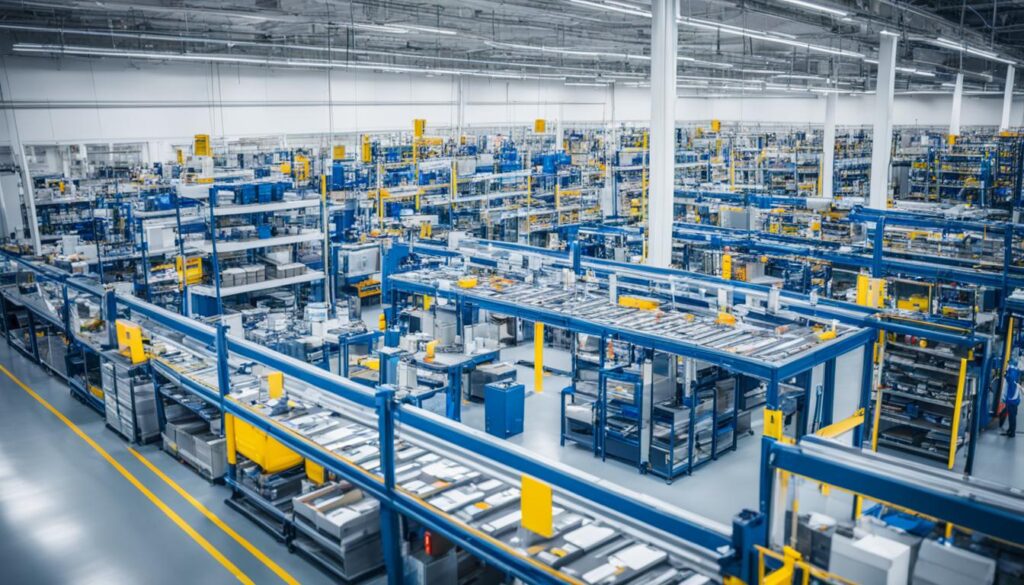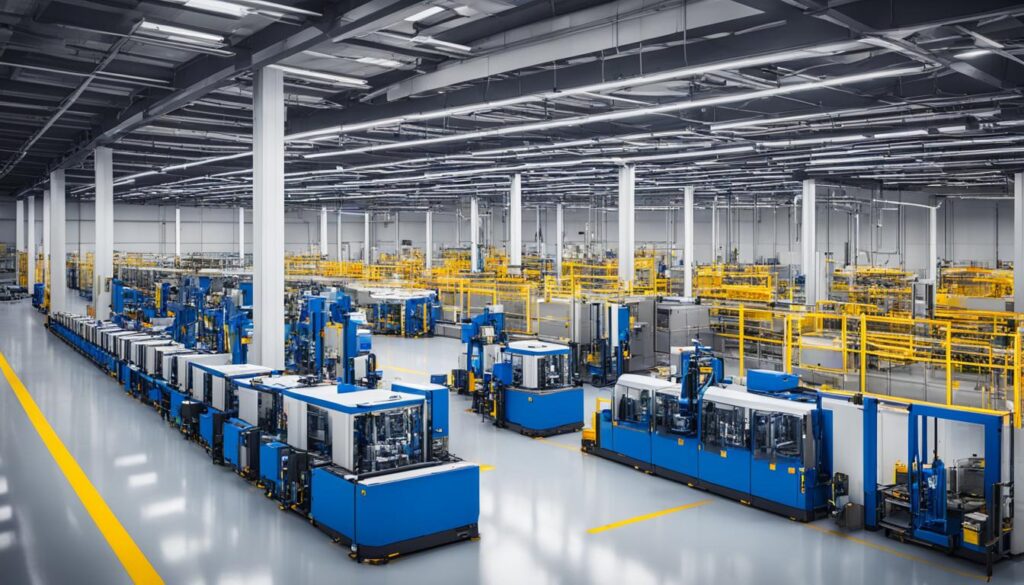Revolutionize Your Stock with Just in Time Inventory

“Inventories can be managed, but people must be led.” – H. Ross Perot
Welcome to the world of just-in-time (JIT) inventory management. If you are looking to revolutionize your stock control system, JIT is the game-changer you’ve been waiting for. With its strategic approach to streamlining production, improving efficiency, and minimizing waste, JIT has the power to transform your business.
Key Takeaways:
- JIT inventory management focuses on synchronized supply and demand.
- Collaboration, foresight, and continuous improvement are key elements of JIT.
- JIT reduces excess inventory, optimizes workflows, and minimizes costs.
- Precision timing and collaboration with suppliers are essential for JIT success.
- JIT is rooted in lean management and the concept of Kaizen.
The Dynamic Core of JIT: Collaboration and Precision
JIT (Just-in-Time) inventory management thrives on collaboration and relies on close relationships with suppliers. The key to its success lies in the precise timing of raw material deliveries, synchronized with production start to prevent surplus or delays. This collaborative approach leads to reduced inventory levels, lower costs, and improved supply chain efficiency.
By implementing JIT inventory management, companies can optimize their inventory and achieve operational excellence. It involves manufacturing products based on real-time demand, minimizing the risk of overproduction and obsolete inventory. This not only improves operational efficiency but also enhances the overall supply chain performance.
Collaboration for Supply Chain Efficiency
The collaborative nature of JIT inventory management fosters strong partnerships with suppliers. Through effective communication and coordination, suppliers can align their deliveries with the production schedule, ensuring the right materials are available at the right time, in the required quantities. This eliminates excess inventory and the associated costs, while increasing supply chain efficiency.
Additionally, JIT encourages continuous improvement and open dialogue with suppliers. By working closely together, organizations can identify opportunities for cost savings, process optimization, and inventory optimization. This collaborative approach leads to a mutually beneficial relationship, driving efficiency throughout the entire supply chain.

JIT inventory management not only focuses on collaboration with suppliers but also on precision in timing and execution. By synchronizing raw material deliveries with production start, companies can prevent stockouts and delays, ensuring a smooth and uninterrupted flow of materials. This precision minimizes inventory holding costs by eliminating the need for excessive safety stock, optimizing space utilization, and reducing the risk of obsolescence.
Furthermore, JIT enables organizations to align their production with real-time demand. By closely monitoring customer demand and adjusting production accordingly, companies can avoid costly overproduction and efficiently meet customer needs. This approach enhances customer satisfaction, decreases lead times, and promotes overall supply chain optimization.
JIT inventory management is the backbone of streamlined operations, enabling companies to achieve supply chain efficiency and optimize inventory. By embracing collaboration and precision, businesses can reduce costs, enhance their competitive advantage, and drive sustainable growth in today’s dynamic market.
Lean Management and Kaizen: Driving JIT’s Philosophy
In the realm of JIT manufacturing, lean management methodologies play a central role in transforming traditional inventory management techniques. Originating from the Japanese concept of Kaizen, which prioritizes continuous improvement and employee participation, JIT goes beyond streamlining processes to become a comprehensive business philosophy.
Just-in-Time (JIT) involves every individual in the production line, making them an essential part of the progress. It fosters a culture of continuous improvement, waste reduction, and quality enhancement, propelling businesses towards innovation, efficiency, and adaptability.
By embracing JIT, companies move away from conventional stockpiling approaches and instead focus on agility, efficiency, and optimization. Lean management principles, infused with JIT, encourage businesses to seek operational excellence by rethinking workflows, reducing waste, and supporting employee engagement.
JIT manufacturing relies on lean management techniques, which aim to eliminate non-value-added activities, optimize processes, and improve overall performance. Lean enforces the elimination of inventory that does not directly contribute to value creation, further reinforcing the JIT philosophy of operating with minimal waste.
Imbibing Kaizen as a core principle helps organizations foster a mindset of continuous improvement, where employees at all levels actively seek out opportunities for betterment. Such an environment allows for greater adaptability and responsiveness to market demands, as well as sustained efforts towards enhancing overall quality.
With lean management and Kaizen driving JIT’s philosophy, businesses are better equipped to thrive in today’s fiercely competitive landscape, where efficiency and innovation are paramount.

Striking a Balance: Quality vs. Cost
Just-in-Time (JIT) inventory management places a strong emphasis on quality control to ensure customer satisfaction and product excellence. While JIT prioritizes quality over cost, it also acknowledges the importance of managing expenses. To strike a balance between quality and cost, companies must establish long-term contracts with reliable suppliers. These partnerships are essential for maintaining a consistent flow of high-quality resources.
By working closely with trusted suppliers, organizations can minimize the risk of stockouts or delays that can compromise production schedules. Reliable suppliers play a crucial role in supporting the JIT philosophy by providing top-notch materials and components on time, allowing businesses to meet customer demands efficiently. This reduces the chances of production downtime and ensures the availability of adequate inventory levels.
JIT inventory management techniques require close collaboration with suppliers to avoid disruptions in the supply chain. Reliability in material delivery guarantees that production schedules remain on track, enabling companies to meet market demands promptly. With reliable suppliers, businesses can build a reputation for consistent product quality, leading to increased customer trust and loyalty.
Moreover, by focusing on quality and reliability over the lowest price, JIT ensures that companies maintain their production standards. Suppliers who prioritize quality align perfectly with JIT’s commitment to producing high-quality goods. This enables businesses to reduce inventory costs by preventing the need for costly reworks or rejections that result from inferior materials.
Striking a balance between quality and cost also allows organizations to optimize their inventory management. By maintaining a uniform level of quality among suppliers, companies can better control the inventory flow, resulting in improved production efficiency and inventory turnover. This, in turn, leads to reduced carrying costs and waste, further enhancing cost efficiency.
To summarize, JIT’s commitment to quality necessitates long-term contracts with reliable suppliers. By investing in these partnerships, businesses can strike a balance between quality and cost, effectively managing their inventory, reducing costs, and mitigating risks.

| Benefits of Striking a Balance between Quality and Cost in JIT Inventory Management: |
|---|
| 1. Consistent product quality |
| 2. Mitigation of stockouts and delays |
| 3. Enhanced production standards |
| 4. Reduced inventory costs |
| 5. Improved production efficiency and inventory turnover |
| 6. Enhanced cost efficiency |
Advantages of Just-In-Time Inventory
JIT (Just-In-Time) inventory management offers a multitude of advantages to businesses, helping them thrive in today’s dynamic market. By embracing JIT, companies can experience improved production efficiency, cost efficiency, waste reduction, enhanced cash flow, flexibility, and quality control.

One of the significant benefits of JIT is the improved production efficiency it brings. By streamlining processes, enhancing workflows, and optimizing productivity, JIT enables businesses to achieve higher levels of efficiency in their operations. This results in faster production cycles, reduced lead times, and greater output in the same amount of time.
The cost efficiency achieved through JIT is another compelling advantage. By reducing inventory carrying costs and minimizing waste, spoilage, and obsolete inventory, businesses can cut down on unnecessary expenses. JIT emphasizes the importance of lean inventory management, ensuring that companies only have the necessary inventory on hand, reducing the cost of holding excess stock.
Furthermore, JIT improves cash flow for businesses. With JIT, less money is tied up in excess stock, allowing for better financial flexibility. Instead of investing heavily in inventory, companies can allocate resources strategically, focusing on other critical areas of their operations. This improved cash flow enables businesses to seize new opportunities and invest in growth.
JIT also brings enhanced flexibility to businesses, allowing them to adapt and respond quickly to market fluctuations and customer demands. Maintaining smaller, more manageable inventory levels allows companies to adjust production volumes and product offerings swiftly. This agility in operations helps companies stay competitive, meet changing customer needs, and seize market opportunities.
Key Benefits of Just-In-Time Inventory:
- Improved production efficiency
- Cost efficiency through waste reduction
- Enhanced cash flow and financial flexibility
- Greater adaptability and responsiveness to market demands
- Streamlined workflows and optimized productivity
- Improved quality control and prompt corrective actions
Lastly, JIT enables businesses to maintain better quality control. By keeping inventory levels smaller and more manageable, companies can closely monitor the quality of their products. Any issues or defects can be detected and addressed promptly, ensuring that only high-quality products reach the customers. This focus on quality control contributes to customer satisfaction, reputation building, and long-term success.
In summary, the advantages of Just-In-Time inventory management are undeniable. Improved production efficiency, cost efficiency, waste reduction, enhanced cash flow, flexibility, and quality control are some of the key benefits that businesses can experience with JIT. By implementing JIT practices, companies can optimize their operations, drive growth, and stay ahead in today’s competitive business landscape.
Conclusion
Just-in-Time (JIT) inventory management techniques have proven to be a game-changer for businesses seeking operational excellence and improved inventory control. By embracing JIT, companies can revolutionize their inventory management practices, optimizing workflows, reducing waste, and enhancing efficiency.
JIT operates on the principle of collaboration and precision. Through strong partnerships with suppliers and synchronized supply and demand, businesses can maintain optimal inventory levels, reduce storage costs, and ensure smoother production processes.
Furthermore, JIT is deeply aligned with the philosophy of lean management and continuous improvement. By fostering a culture of employee participation, waste reduction, and quality enhancement, JIT enables companies to continuously evolve and adapt to changing market demands.
In summary, by implementing JIT inventory management techniques, businesses can achieve improved inventory control, cost efficiency, and enhanced operational performance. The focus on efficiency, waste reduction, and collaboration ultimately transforms companies into lean, dynamic entities that can thrive in today’s competitive landscape.






